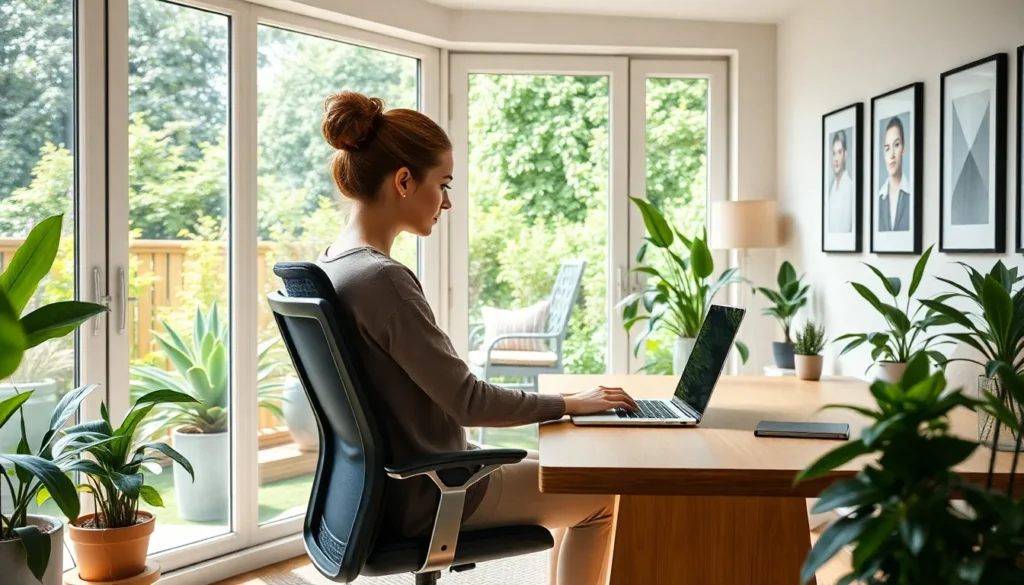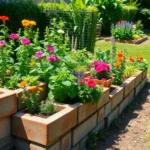We’ve all felt the pull toward creating the perfect workspace where productivity meets tranquility. Garden offices have become the ultimate solution for those seeking a dedicated work environment that’s both separate from home distractions and immersed in nature’s calming presence.
But here’s the thing – designing the interior of your garden office requires more than just moving a desk outdoors. The right interior choices can transform a simple shed into a professional sanctuary that rivals any corporate boardroom while maintaining that peaceful garden connection we’re all craving.
From maximizing natural light to choosing furniture that withstands temperature fluctuations, we’ll explore practical design strategies that make your garden office both beautiful and functional. Whether you’re working with a compact pod or a spacious studio, these interior ideas will help you create a workspace that inspires creativity and boosts productivity year-round.
Create a Productive Workspace with Ergonomic Furniture Solutions
Building on the foundation of natural light and durable materials, we must prioritize ergonomic furniture to maintain comfort and productivity throughout long working days in our garden office.
Choose the Right Desk Height and Size
Standard desk height should measure between 28 to 30 inches to accommodate most body types and reduce strain on shoulders and wrists. We recommend adjustable height desks that allow us to switch between sitting and standing positions throughout the day. For garden office spaces measuring 8×10 feet or smaller, compact desks spanning 48 to 55 inches provide adequate workspace without overwhelming the room.
Corner desks maximize limited square footage while offering multiple work surfaces for computers, documents, and decorative plants. L-shaped configurations create distinct zones for focused work and video calls. We’ve found that desks with built-in storage drawers eliminate clutter and keep essential supplies within arm’s reach.
Desktop depth between 24 to 30 inches ensures proper monitor placement and prevents us from hunching forward while typing. Solid wood surfaces like oak or walnut complement the natural garden setting while providing durability against temperature fluctuations.
Invest in a Supportive Office Chair
Ergonomic office chairs with lumbar support reduce back pain and improve posture during extended work sessions. We need chairs that adjust to our exact height, with seat depth measuring 16 to 17 inches to support different leg lengths. Quality office chairs include 4-way adjustable armrests that align with desk height and reduce shoulder tension.
Breathable mesh backs prevent overheating in garden offices where ventilation may be limited compared to indoor spaces. Memory foam seat cushions distribute weight evenly and maintain their shape over time. We recommend chairs with tilt mechanisms that allow us to recline slightly while maintaining proper spine alignment.
Investment grade chairs ranging from $300 to $800 provide warranties spanning 5 to 12 years and daily use ratings of 8+ hours. Popular models include the Herman Miller Aeron, Steelcase Leap, and Humanscale Freedom chairs that professionals trust for home office environments.
Add Adjustable Monitor Stands
Monitor stands elevate screens to eye level and prevent neck strain that develops from looking down at laptop displays. We position monitors 20 to 26 inches from our eyes to reduce digital eye strain and maintain focus throughout the workday. Dual monitor setups require stands that support 24 to 27 inch displays while conserving valuable desk space.
Height adjustable stands accommodate users between 5’2″ and 6’4″ through telescoping arms and tilt mechanisms. Rotating features allow us to switch between industry and portrait orientations for different tasks like coding, writing, or graphic design. Cable management systems route power and data cables beneath the desk surface to maintain our garden office’s clean aesthetic.
Tablet and laptop stands complement primary monitors by creating secondary displays for reference materials, video calls, or productivity apps. Portable aluminum stands fold flat for storage and weigh less than 2 pounds for easy repositioning around our garden workspace.
Maximize Natural Light with Strategic Window Treatments
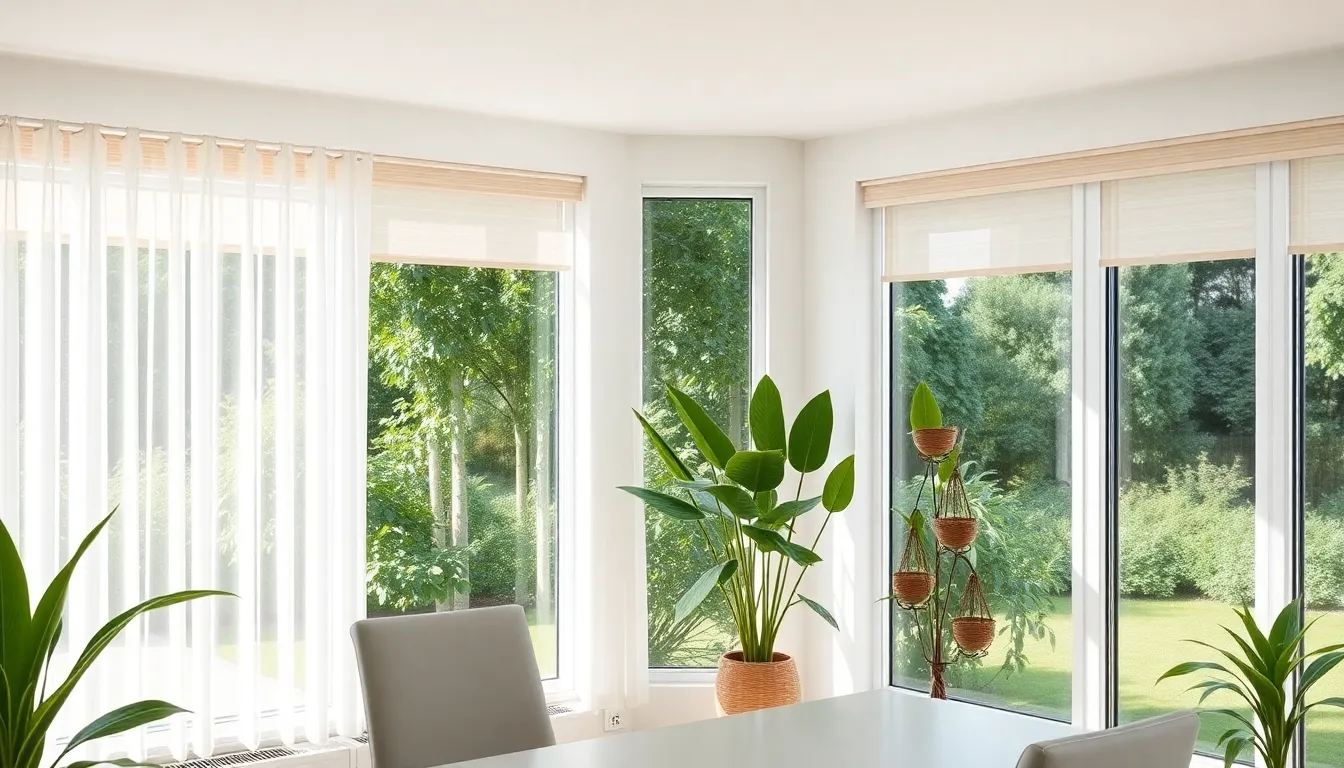
Natural light transforms garden office spaces into vibrant, energizing work environments that boost productivity and well-being. We’ll explore three strategic window treatment approaches that enhance illumination while maintaining the professional atmosphere your workspace needs.
Install Sheer Curtains for Soft Lighting
Sheer curtains create the perfect balance between privacy and natural illumination in garden office settings. We recommend installing these lightweight fabrics to allow soft, diffused light into your workspace while maintaining visual separation from outdoor distractions.
The translucent properties of sheer materials filter harsh sunlight without blocking essential daylight that keeps us alert and focused. Installation becomes straightforward with tension rods or ceiling mounted tracks that won’t damage your garden office structure.
White or cream colored sheers work best for maximizing light transmission, while still providing enough coverage for screen glare reduction during video calls. We’ve found that layering sheers with other window treatments gives you flexibility to adjust lighting conditions throughout the day.
Use Light-Filtering Blinds for Glare Control
Light filtering blinds offer precise control over illumination levels while reducing computer screen glare that can strain our eyes during long work sessions. We suggest choosing blinds with adjustable slats that let you direct natural light toward the ceiling for ambient lighting rather than directly onto work surfaces.
Horizontal blinds work particularly well in garden offices because they allow you to maintain views of your outdoor space while controlling the intensity of incoming light. The ability to tilt slats gives us granular control over brightness levels throughout different times of day.
Cellular or honeycomb blinds provide excellent light filtering capabilities while adding insulation properties that help regulate temperature in your garden office. We recommend choosing light colored materials that reflect heat while still allowing gentle illumination to filter through.
Position Mirrors to Reflect Garden Views
Strategic mirror placement doubles the visual impact of your garden surroundings while amplifying available natural light throughout your workspace. We position mirrors opposite windows to reflect outdoor views and create an illusion of expanded space that makes compact garden offices feel more open.
Large mirrors placed perpendicular to windows bounce light into darker corners of your office, ensuring even illumination across all work areas. The reflection of garden scenery through mirrors enhances the biophilic design elements that connect us with nature during work hours.
We’ve discovered that angled mirrors work exceptionally well for capturing and redirecting light from multiple window sources, particularly in garden offices with windows on adjacent walls. Choose mirrors with thin frames or frameless designs to maintain clean, modern aesthetics that complement your professional workspace.
Design Efficient Storage Systems for Small Spaces
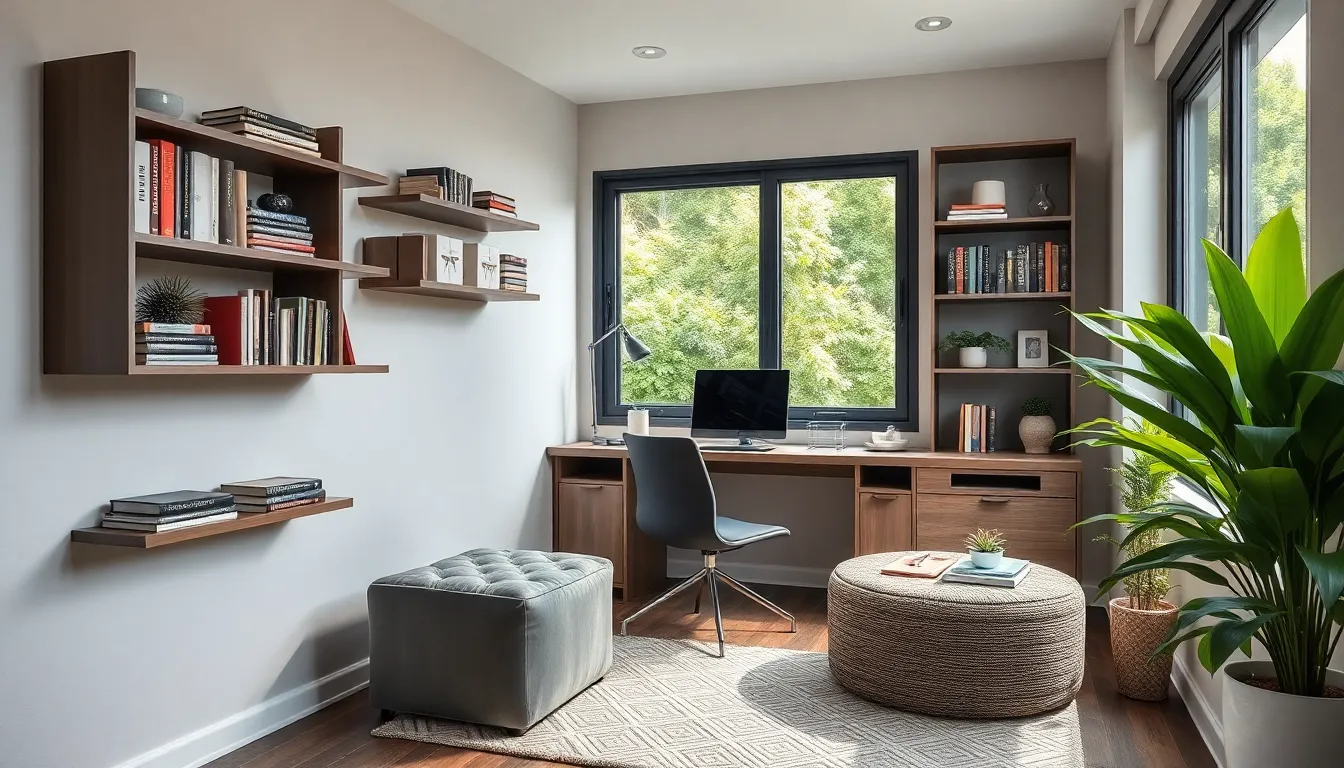
Maximizing storage in compact garden offices requires strategic planning and clever answers. We’ll explore three key approaches that transform limited square footage into highly organized and functional workspaces.
Install Wall-Mounted Shelving Units
Wall-mounted shelving units maximize vertical space without consuming valuable floor area in your garden office. These systems keep rooms clutter-free while maintaining clean aesthetics that enhance productivity. Floating shelves work particularly well for displaying books, decorative items, and frequently used supplies within easy reach.
Choose adjustable bracket systems that accommodate different shelf heights as your storage needs evolve. Metal brackets with wood or glass shelves create modern looks that complement natural garden settings. Position shelves at eye level for everyday items and higher for seasonal storage or reference materials.
Consider installing corner shelving units to use otherwise wasted wall space. These triangular configurations fit perfectly in tight areas while providing substantial storage capacity for office supplies and personal items.
Use Multi-Functional Furniture with Hidden Storage
Multi-functional furniture with built-in storage transforms every piece into a storage opportunity while maintaining organized workspaces. Desks with drawers keep essential items accessible without cluttering your work surface. File cabinets positioned under work surfaces serve dual purposes as both storage and additional desk support.
Ottoman storage benches provide seating for visitors while concealing office supplies, extra cables, and seasonal items inside. These versatile pieces work especially well in small garden offices where every item must serve multiple functions.
Storage coffee tables offer surface space for meetings while hiding documents, chargers, and backup equipment in compartments below. Choose pieces with soft-close hinges and quality hardware that withstand frequent daily use in outdoor office environments.
Create Vertical Filing Answers
Vertical filing systems efficiently store documents and paperwork using minimal floor space in compact garden offices. Stackable file organizers allow you to build storage towers that adapt to your document volume over time. These modular systems work particularly well for project-based filing where categories change frequently.
Hanging file folders maximize drawer space by utilizing full depth and height dimensions. Install drawer slides rated for heavy loads to support multiple hanging folders filled with important documents. Label tabs clearly to maintain quick access to critical files during busy workdays.
Wall-mounted file holders keep frequently referenced documents visible and accessible without opening drawers. These systems work well for ongoing projects, invoices, and daily reference materials that you need at a peek.
Incorporate Biophilic Design Elements to Connect with Nature
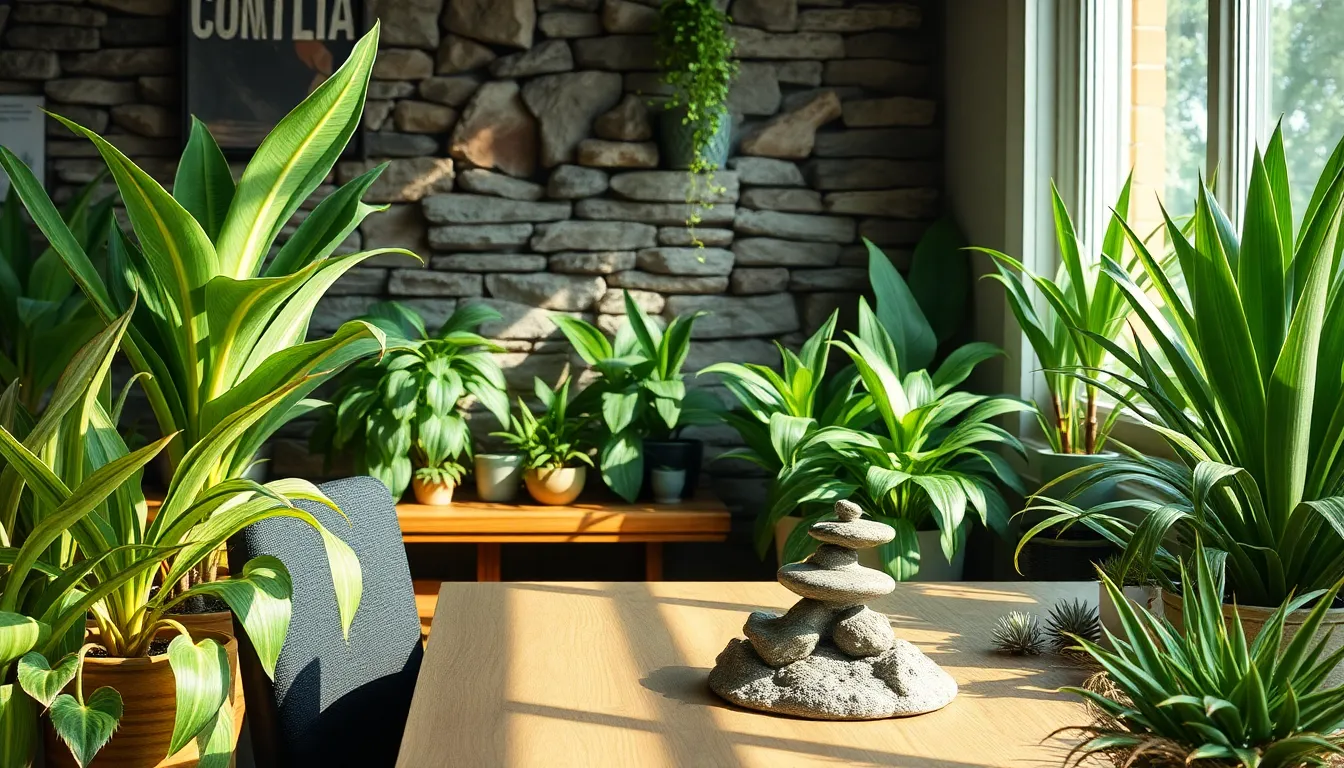
Biophilic design transforms our garden office into a sanctuary that naturally boosts productivity and well-being. We’ll create a seamless connection between our indoor workspace and the natural industry outside through strategic design choices.
Add Indoor Plants and Green Walls
Indoor plants serve as natural air purifiers while creating a lush environment that energizes our workspace. We can incorporate vertical gardening answers using wall-mounted planters to optimize space without cluttering our desk area. Green walls work particularly well along bare walls, transforming them into living features that improve air quality and reduce stress levels.
Wall-mounted planters allow us to create cascading displays of trailing plants like pothos or philodendrons. We’ll position larger floor plants such as snake plants or rubber trees in corners where they won’t interfere with our workflow. Desk-friendly options include succulents and small herbs that add greenery while requiring minimal maintenance.
Vertical gardening systems maximize our connection to nature without sacrificing valuable floor space. We can install modular planting systems that let us customize our green wall based on lighting conditions and plant preferences.
Use Natural Materials Like Wood and Stone
Wood and stone elements bring warmth and texture to our garden office while reinforcing our connection to the outdoors. We’ll incorporate these materials into furniture pieces and accent features to enhance the biophilic atmosphere. Natural wood surfaces work exceptionally well for desks, shelving, and decorative elements that complement our garden setting.
Stone accents can appear in various forms, from decorative bowls to textured wall panels that add visual interest. We might choose reclaimed wood for desktop surfaces or floating shelves that showcase the natural grain patterns. Bamboo accessories offer sustainable alternatives while maintaining the organic aesthetic we’re creating.
Natural materials create tactile experiences that synthetic alternatives simply can’t replicate. We’ll select pieces that highlight the unique characteristics of each material, such as live-edge wood surfaces or river rock accents.
Include Water Features for Ambient Sound
Water features generate soothing ambient sounds that mask distracting noises while creating a calming environment. We can incorporate tabletop fountains that fit comfortably on desk surfaces or nearby shelves without overwhelming our workspace. Small water features foster peaceful atmospheres that naturally promote focus and productivity.
Tabletop fountains come in various styles, from modern minimalist designs to natural stone arrangements that complement our biophilic theme. We’ll position these features where the gentle sound can be heard throughout our office without becoming distracting during phone calls or video meetings.
Water elements also add humidity to our space, which benefits both us and our indoor plants during dry seasons. We can choose fountains with adjustable flow rates to control sound levels based on our current activities and preferences.
Choose Color Schemes That Enhance Focus and Creativity
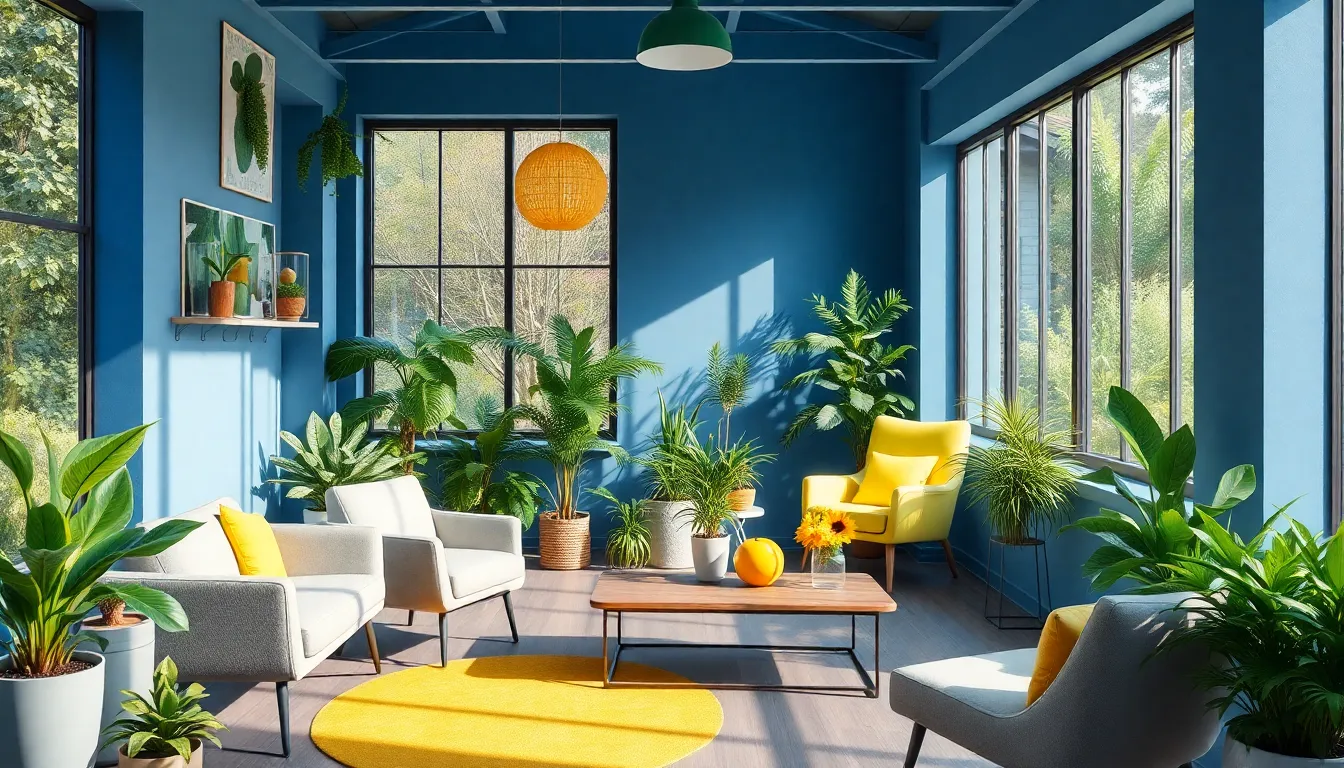
Color selection plays a crucial role in creating an effective garden office environment that supports both productivity and mental well-being. Strategic color choices can significantly impact our mood, cognitive function, and overall work performance throughout the day.
Apply Calming Blues and Greens for Concentration
Blues and greens create the ideal foundation for sustained focus in our garden office spaces. Blue tones naturally promote mental clarity and calmness, helping us maintain concentration during demanding work sessions. We can incorporate these colors through wall paint, upholstery choices, or decorative soft furnishings to establish a tranquil atmosphere.
Green shades connect our indoor workspace directly to the natural surroundings visible through large windows and glass doors. This biophilic approach reduces stress levels while improving our overall sense of well-being during work hours. Modular furniture pieces in these calming hues complement open shelving systems for a cohesive, modern aesthetic.
Strategic placement of blue and green elements throughout the space reinforces the connection between our productivity goals and nature’s calming influence. Plants with varying green tones can bridge the gap between painted surfaces and the garden views beyond our workspace.
Use Energizing Yellow Accents for Inspiration
Yellow accents inject essential energy and optimism into our garden office environment without overwhelming the professional atmosphere. Strategic yellow placement through artwork, decorative accessories, or selected furniture pieces stimulates creativity and maintains our motivation throughout long work sessions.
We achieve the best results when yellow serves as an accent color rather than the dominant shade in our color scheme. Bright yellow desk accessories, inspirational wall art, or vibrant throw pillows can transform neutral spaces into ever-changing work environments.
Combining yellow accents with muted base palettes creates visual interest while supporting sustained productivity. This energizing color works particularly well in areas where we engage in creative brainstorming or problem solving activities.
Carry out Neutral Tones for Professional Appeal
Neutral tones including white, gray, and beige establish a clean, professional backdrop that makes our garden office feel spacious and organized. These versatile colors maximize the impact of abundant natural light that flows through glass walls and windows.
We can easily update neutral color schemes with seasonal decor changes or new accent colors as our preferences evolve. White walls reflect available light effectively, while gray furniture pieces provide sophisticated contrast against garden views.
Beige elements add warmth to the workspace without compromising the professional aesthetic we need for client meetings or video calls. Neutral foundations support our ability to maintain focus while creating an environment that adapts to various work activities throughout the day.
| Color Scheme | Effect on Workspace | Suggested Use |
|---|---|---|
| Blue/Green | Calming, concentration | Main wall color, furnishings |
| Yellow | Energizing, inspiration | Accents, decor, art |
| Neutral | Professional, spacious | Base color, furniture |
Install Proper Lighting for All-Day Productivity

Strategic lighting transforms your garden office into a workspace that maintains energy and focus throughout every workday. We’ll position large windows or skylights to maximize natural light, which reduces eye strain and supports overall well-being while taking advantage of your garden office’s proximity to outdoor spaces.
Set Up Task Lighting for Detailed Work
Precision activities like reading, writing, or computer work demand focused illumination that minimizes glare and shadows. We recommend installing desk lamps with adjustable arms and dimmable, high-CRI LED bulbs that provide targeted light exactly where you need it most. Select models with flexible heads to direct light precisely onto your workspace, improving accuracy while reducing eye fatigue during detailed tasks.
Adjustable task lighting becomes essential when natural light isn’t sufficient for concentrated work. Position these lamps to complement your primary lighting sources, creating layered illumination that adapts to different work requirements throughout the day.
Add Ambient Lighting for Evening Hours
Comfortable ambient lighting creates the perfect atmosphere for continued productivity during late hours in your garden office. We suggest incorporating soft, diffuse light from wall sconces, floor lamps, or linear LED strips around coves and shelving areas. These fixtures provide gentle illumination that reduces harsh contrasts and supports relaxation after sunset.
Ambient lighting works particularly well when installed around your garden office perimeter, creating a warm glow that maintains comfort without overwhelming your workspace. Strategic placement of these fixtures ensures consistent light distribution while avoiding glare on computer screens.
Include Accent Lighting for Visual Interest
Accent lighting highlights architectural features, artwork, or plants while adding depth and visual appeal to your garden office interior. We use spotlights, picture lights, or LED strip lights placed under shelves or behind objects to create ever-changing lighting effects that enhance your workspace’s overall aesthetic.
Modern garden offices often feature bold lighting designs such as geometric pendant lights or sculptural floor lamps that serve as striking focal points. These statement pieces combine functionality with visual interest, transforming your garden office into an inspiring environment that motivates productivity while showcasing your personal style.
Optimize Climate Control for Year-Round Comfort
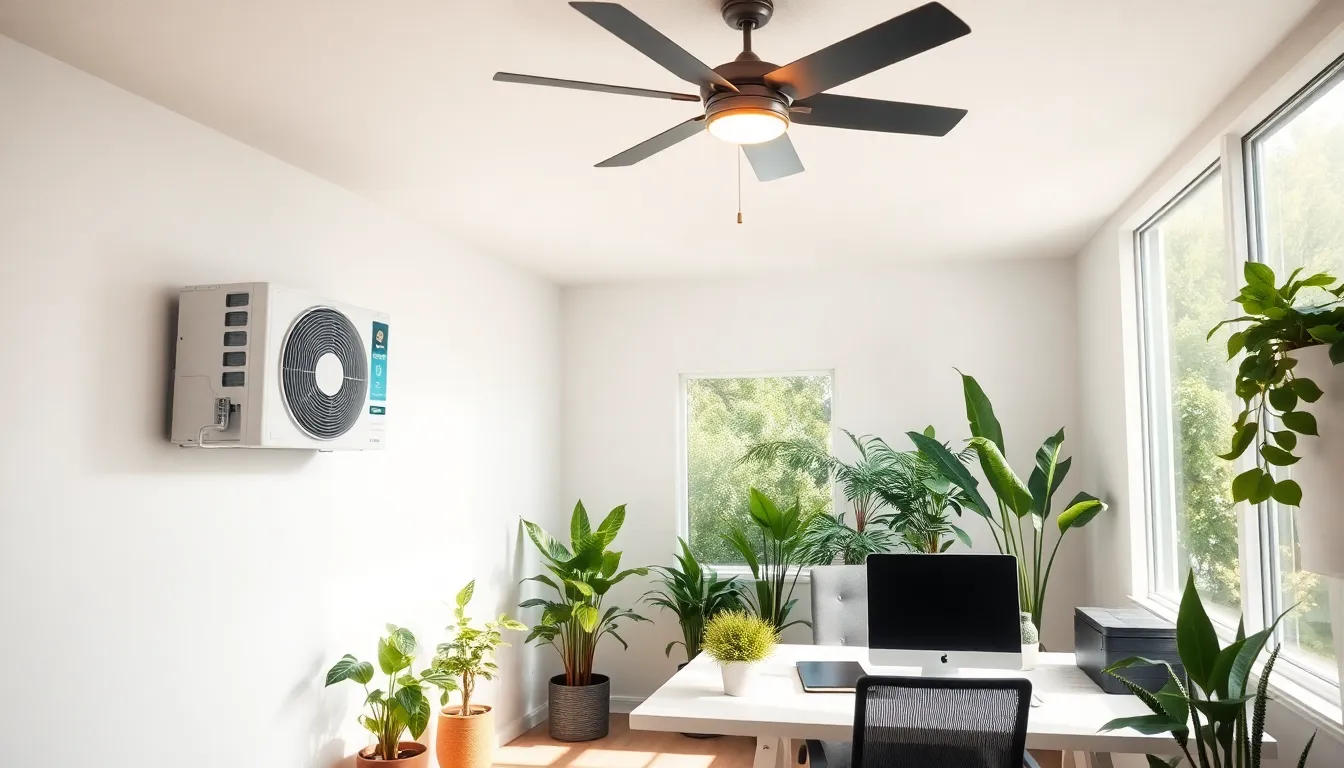
Maintaining comfortable temperatures throughout all seasons transforms your garden office into a productive workspace that you’ll actually want to use.
Install Efficient Heating and Cooling Systems
Smart heating and cooling systems ensure consistent temperatures while keeping energy costs manageable in your garden office space. Energy efficient units customized to your exact square footage provide optimal performance without oversizing or undersizing issues that waste electricity.
Ductless mini split systems offer excellent zone control for garden offices since they don’t require extensive ductwork installation. These systems typically consume 25 to 50 percent less energy than traditional HVAC units while providing both heating and cooling capabilities.
Electric radiant heaters work exceptionally well for quick warmth during colder months since they heat objects directly rather than warming the air. Portable air conditioning units serve as cost effective cooling answers for smaller garden offices under 400 square feet.
Use Ceiling Fans for Air Circulation
Ceiling fans enhance the efficiency of your primary heating and cooling systems by circulating air throughout your garden office space. Proper air movement allows you to set thermostats 3 to 4 degrees higher in summer and lower in winter while maintaining the same comfort level.
Reversible ceiling fans provide year round benefits by pushing warm air down during winter months and creating cooling breezes during summer. Choose fans with variable speed controls to adjust airflow based on seasonal needs and occupancy levels.
Energy Star certified ceiling fans use up to 60 percent less energy than conventional models while moving the same volume of air. Installing fans with LED lighting fixtures maximizes functionality while reducing overall electricity consumption in your garden office.
Add Insulation for Temperature Regulation
Proper insulation creates a thermal barrier that maintains stable indoor temperatures regardless of external weather conditions. Quality insulation reduces heat loss during winter months and prevents unwanted heat gain during summer, making your climate control systems work more efficiently.
Spray foam insulation provides superior air sealing properties compared to traditional fiberglass batts, reducing energy costs by up to 50 percent. This type of insulation expands to fill gaps and cracks that typically allow conditioned air to escape from garden office structures.
Wall insulation with R values between R13 and R15 suits most garden office applications in moderate climates. Ceiling insulation should achieve R30 to R38 ratings for optimal thermal performance, while floor insulation requires R19 to R25 depending on your local climate zone.
Reflective insulation barriers work particularly well in garden offices since they reflect radiant heat away from the structure during hot weather. These barriers can reduce cooling costs by 5 to 10 percent when properly installed in attic spaces or under roofing materials.
Create Designated Zones for Different Work Activities
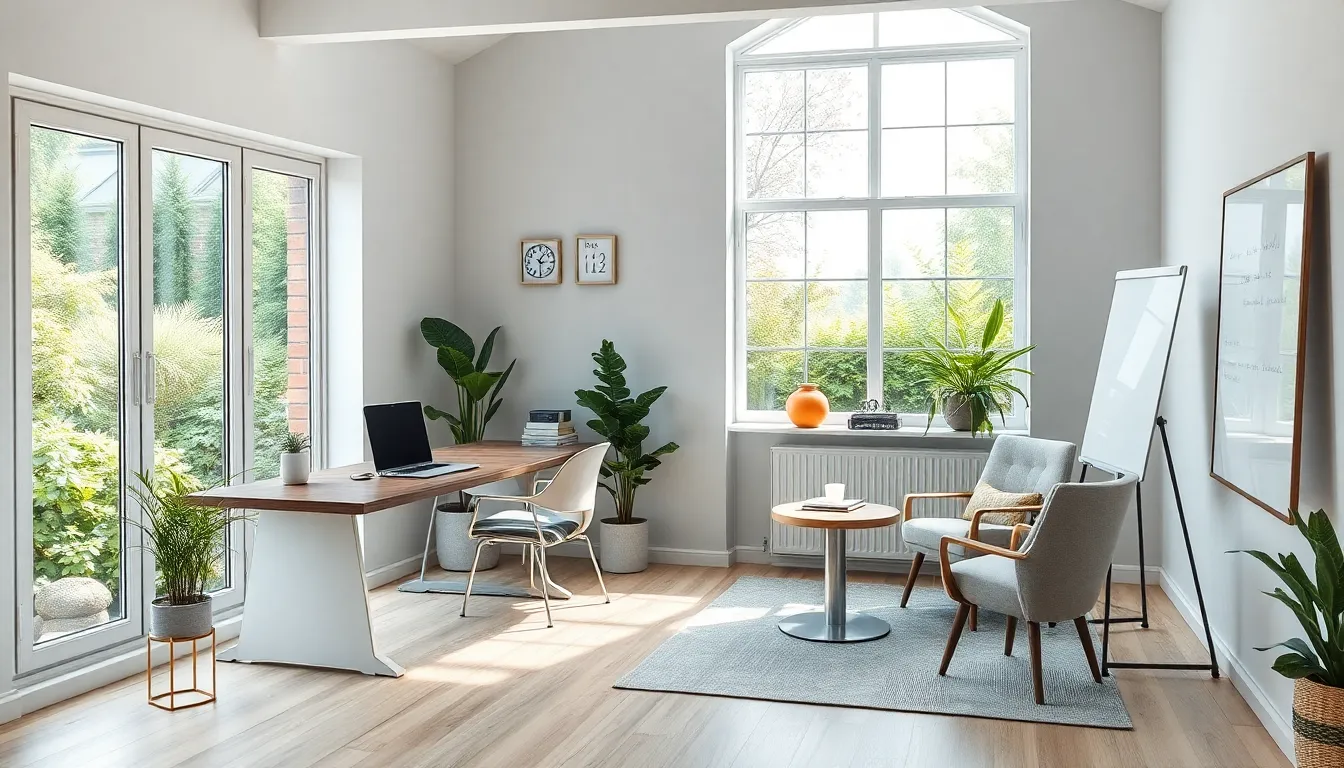
We can transform our garden office into a highly functional workspace by establishing distinct zones that cater to exact work activities. This strategic approach maximizes productivity while maintaining the serene atmosphere that makes garden offices so appealing.
Establish a Main Work Area with Computer Setup
Position your desk to take advantage of natural light while ensuring screen glare doesn’t interfere with daily tasks. We recommend placing the computer setup near windows but at an angle that prevents direct sunlight from hitting the monitor.
Choose a desk with ample surface space for your computer and essential office supplies. Minimalist aesthetics work best in garden offices, featuring clean lines and neutral colors that complement the natural surroundings.
Incorporate stylish yet functional lighting answers such as geometric pendant lights suspended above the workspace or adjustable desk lamps for focused task work. LED options provide energy efficiency while offering the flexibility to adjust brightness throughout the day.
Install cable management systems to maintain the clean aesthetic that makes garden offices feel organized and peaceful. Wall mounted cable trays or desktop organizers keep power cords and data cables neatly arranged.
Design a Reading and Planning Corner
Create a cozy reading nook separate from your main computer workspace using comfortable seating like an upholstered armchair or cushioned bench. This designated area encourages different types of thinking and provides a mental break from screen based work.
Add a small side table or compact bookshelf within arm’s reach for planning materials, reference books, and notepads. Floating shelves work particularly well in smaller garden offices where floor space is limited.
Install dedicated reading lighting such as a floor lamp with an adjustable arm or wall mounted sconces that provide focused illumination without disturbing the main work area. Warm light temperatures around 2700K create a relaxing atmosphere for reading and reflection.
Position comfortable seating to face garden views when possible, allowing natural scenery to inspire creative thinking and strategic planning sessions.
Include a Meeting Space for Video Calls
Designate a exact area for virtual meetings that’s separate from your daily work setup, ensuring a professional background for video conferencing. We suggest positioning this space against a wall with built in shelving or attractive wall treatments.
Ensure adequate lighting for video calls by placing the meeting area near a window or installing a ring light to eliminate shadows on your face. Natural light from the side provides the most flattering illumination for virtual meetings.
Add a large screen or smart board mounted on the wall for presentations and collaborative work sessions with remote team members. Interactive displays enhance engagement during virtual meetings and brainstorming sessions.
Include comfortable seating options like a swivel chair that can easily transition between your main desk and meeting area, or a dedicated chair positioned for optimal camera angles during video conferences.
Add Personal Touches to Inspire and Motivate
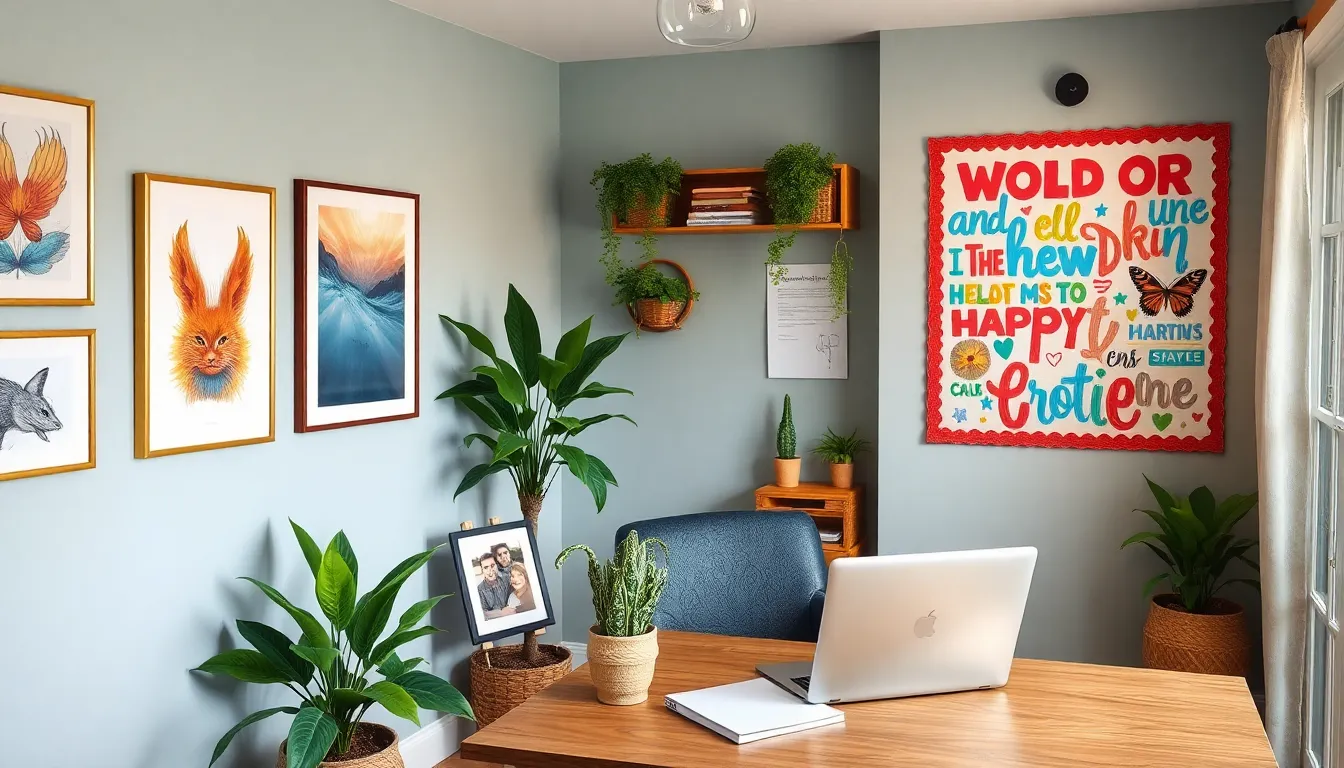
Transforming your garden office into a motivating workspace requires intentional personal elements that reflect your unique style and aspirations. We’ve found that incorporating meaningful personal touches creates an environment that feels both professional and inspiring.
Display Artwork and Inspirational Quotes
Artwork displays create visual focal points that energize your garden office throughout the workday. We recommend selecting pieces that resonate with your personal taste while complementing your neutral color palette foundation. Bold abstract pieces serve as striking focal points against minimalist backgrounds, while geometric lighting fixtures add contemporary appeal to your workspace.
Inspirational quotes positioned at eye level provide daily motivation when productivity wanes. Consider placing quotes on floating shelves near your main work area or incorporating them into gallery wall arrangements. Research demonstrates that visually captivating environments with inspirational elements significantly boost workplace productivity and focus.
Strategic placement ensures maximum impact from your chosen artwork and quotes. We suggest positioning larger pieces on walls facing your primary workspace, allowing natural light to illuminate the displays throughout the day. Smaller inspirational elements work well near task lighting areas where you’ll frequently reference them during detailed work sessions.
Include Personal Photos and Mementos
Family photographs create an immediate sense of comfort and connection in your garden office space. We recommend displaying framed family pictures on floating shelves or your desk area, ensuring they don’t interfere with your primary work zones. These personal elements make the space feel welcoming while maintaining professional boundaries for video calls.
Travel souvenirs add personality and conversation starters to your workspace without overwhelming the clean aesthetic. Consider incorporating small sculptures, unique desk accessories, or cultural artifacts that spark positive memories. Wicker baskets provide stylish storage for rotating collections of meaningful items you’ve gathered over time.
Professional awards deserve prominent display to reinforce your accomplishments and boost confidence during challenging work periods. We suggest creating a small recognition area on wall-mounted shelving units, allowing these achievements to motivate you without dominating the overall design scheme.
Create a Vision Board for Goals
Strategic positioning ensures your vision board remains visible throughout your workday without creating visual clutter. We recommend placing goal boards on walls adjacent to your primary workspace, allowing for easy reference during planning sessions. Open shelving systems provide flexible mounting options that can accommodate different board sizes and styles.
Professional objectives displayed through images and affirmations reinforce your commitment to career advancement. Research shows that visually representing goals increases motivation and productivity by keeping aspirations at the forefront of daily activities. Include images of desired achievements, target metrics, or industry milestones you’re working toward.
Personal aspirations balance professional focus with life goals that provide deeper meaning to your work efforts. We suggest incorporating travel destinations, lifestyle images, or personal development objectives alongside career-focused elements. This comprehensive approach creates a vision board that motivates both professional success and personal fulfillment in your garden office environment.
Conclusion
We’ve explored comprehensive strategies that transform ordinary garden spaces into extraordinary productive workspaces. From ergonomic furniture selections to biophilic design elements these interior ideas create environments that boost both creativity and efficiency.
Your garden office should reflect your unique work style while maintaining professional functionality. By implementing these design principles you’ll create a space that seamlessly blends comfort productivity and natural beauty.
Remember that successful garden office design isn’t about following every trend—it’s about selecting elements that enhance your daily work experience. Start with the basics like proper lighting and storage then gradually add personal touches that inspire your best work.
Frequently Asked Questions
What makes a garden office different from a regular home office?
A garden office combines productivity with a serene natural environment, offering better work-life separation and improved mental well-being. Unlike indoor home offices, garden offices require specific considerations for natural lighting, climate control, and weather-resistant materials while providing direct connection to nature.
What desk height is recommended for garden offices?
Standard desk heights should be between 28 to 30 inches for optimal ergonomics. Adjustable desks are ideal for flexibility, allowing you to customize the height based on your needs. For smaller garden offices, consider compact corner desks or L-shaped configurations to maximize space efficiency.
How can I maximize natural light in my garden office?
Use sheer curtains for soft lighting that balances privacy and illumination, install light-filtering blinds for glare control, and strategically place mirrors to reflect garden views. Consider large windows or skylights to maximize daylight exposure while maintaining a comfortable working environment.
What storage solutions work best for small garden offices?
Install wall-mounted shelving units with adjustable brackets to maximize vertical space. Choose multi-functional furniture with hidden storage, such as desks with drawers and ottoman storage benches. Vertical filing systems and stackable organizers help maintain organization while minimizing floor space usage.
How do I control temperature in my garden office year-round?
Install ductless mini-split systems for energy efficiency, use electric radiant heaters for quick warmth, and consider portable air conditioning units for smaller spaces. Proper insulation with spray foam and reflective barriers is essential for maintaining stable temperatures and reducing energy costs.
What colors work best for garden office productivity?
Use calming blues and greens to enhance concentration and reduce stress. Add energizing yellow accents for inspiration and creativity. Neutral tones create a professional appeal and versatile backdrop. These colors can be applied through wall paint, furnishings, and decorative accessories.
How should I incorporate plants into my garden office design?
Add indoor plants and green walls to improve air quality and reduce stress through biophilic design. Choose low-maintenance plants that thrive in your office’s lighting conditions. Plants help create a seamless connection between your indoor workspace and the natural garden environment outside.
What lighting setup is ideal for garden office productivity?
Combine natural light from large windows with task lighting using adjustable desk lamps with dimmable LED bulbs. Add ambient lighting for evening work and accent lighting to highlight architectural features. This layered approach ensures proper illumination throughout the day while reducing eye strain.
How can I create different work zones in my garden office?
Establish a main computer work area that maximizes natural light, create a cozy reading corner for planning activities, and designate a professional meeting space for video calls. Each zone should have appropriate lighting and furniture to support its specific function and workflow.
What personal touches should I add to my garden office?
Display inspirational artwork and quotes to energize your workspace, include personal photos and mementos for comfort, and showcase travel souvenirs or professional awards for motivation. Consider creating a vision board to visualize your goals while maintaining a balance between personal and professional elements.

